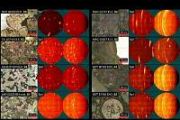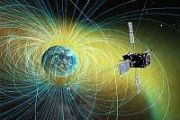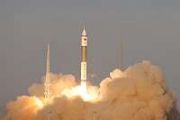
Copernical Team
UK suffers marine heatwave
 Image:
Some of the most severe marine heat increases on Earth are occurring in the seas surrounding the UK and Ireland. Satellite measurements show that water temperatures in certain areas are above average for this time of year.
Image:
Some of the most severe marine heat increases on Earth are occurring in the seas surrounding the UK and Ireland. Satellite measurements show that water temperatures in certain areas are above average for this time of year. European leaders host Musk, chase Tesla investment
 Billionaire Elon Musk swept into Paris on Friday to hold court at an event with thousands of spectators hours after meeting the leaders of Italy and France, as European capitals jostle for investment from his electric car firm Tesla.
He told the audience at the huge VivaTech trade fair his ambition was to put neurone implants in a human brain this year and defended his controversial decision
Billionaire Elon Musk swept into Paris on Friday to hold court at an event with thousands of spectators hours after meeting the leaders of Italy and France, as European capitals jostle for investment from his electric car firm Tesla.
He told the audience at the huge VivaTech trade fair his ambition was to put neurone implants in a human brain this year and defended his controversial decision This salty gel could harvest water from desert air
 MIT engineers have synthesized a superabsorbent material that can soak up a record amount of moisture from the air, even in desert-like conditions.
As the material absorbs water vapor, it can swell to make room for more moisture. Even in very dry conditions, with 30 percent relative humidity, the material can pull vapor from the air and hold in the moisture without leaking. The water could
MIT engineers have synthesized a superabsorbent material that can soak up a record amount of moisture from the air, even in desert-like conditions.
As the material absorbs water vapor, it can swell to make room for more moisture. Even in very dry conditions, with 30 percent relative humidity, the material can pull vapor from the air and hold in the moisture without leaking. The water could Aerojet Rocketdyne hot fires large solid rocket motor for next generation MRBM target
 Aerojet Rocketdyne has completed the qualification static fire test of the eSR-19, the advanced large solid rocket motor that will power the Missile Defense Agency's (MDA) next generation Medium Range Ballistic Missile (MRBM) target used to test our nation's missile defense systems.
"I applaud the dedicated efforts by teams across Aerojet Rocketdyne to meet this important milestone," said
Aerojet Rocketdyne has completed the qualification static fire test of the eSR-19, the advanced large solid rocket motor that will power the Missile Defense Agency's (MDA) next generation Medium Range Ballistic Missile (MRBM) target used to test our nation's missile defense systems.
"I applaud the dedicated efforts by teams across Aerojet Rocketdyne to meet this important milestone," said Searching for an atmosphere on the rocky exoplanet TRAPPIST-1 c
 Using the James Webb Space Telescope, an MPIA-led group of astronomers searched for an atmosphere on rocky exoplanet TRAPPIST-1 c. Although the planet is nearly identical in size and temperature to Venus, its atmosphere has turned out to be very different. By analysing the heat emitted from the planet, they conclude it may only have a tenuous atmosphere with minimal carbon dioxide.
However
Using the James Webb Space Telescope, an MPIA-led group of astronomers searched for an atmosphere on rocky exoplanet TRAPPIST-1 c. Although the planet is nearly identical in size and temperature to Venus, its atmosphere has turned out to be very different. By analysing the heat emitted from the planet, they conclude it may only have a tenuous atmosphere with minimal carbon dioxide.
However Telstra and OneWeb seal deal on delivering new satellite solutions
 Telstra and OneWeb are set to deliver one of the world's largest rollouts of OneWeb low Earth Orbit (LEO) backhaul for a commercial mobile network. After testing in Australia, Telstra and OneWeb have agreed commercial terms and will begin moving hundreds of existing remote mobile base stations currently using satellite backhaul to OneWeb's LEO solution from later this year. Meanwhile, Telstra wi
Telstra and OneWeb are set to deliver one of the world's largest rollouts of OneWeb low Earth Orbit (LEO) backhaul for a commercial mobile network. After testing in Australia, Telstra and OneWeb have agreed commercial terms and will begin moving hundreds of existing remote mobile base stations currently using satellite backhaul to OneWeb's LEO solution from later this year. Meanwhile, Telstra wi Mitsubishi Electric demonstrates light source module for high-capacity laser links
 Mitsubishi Electric Corporation has successfully demonstrated laser optical frequency control using a new light source module, a key component of an envisioned high-capacity laser optical communication network to be deployed in outer space.
The module, which produces a 1.5-um wavelength signal, was installed in the OPTIMAL-1 nanosatellite developed through an industry-academia collaboratio
Mitsubishi Electric Corporation has successfully demonstrated laser optical frequency control using a new light source module, a key component of an envisioned high-capacity laser optical communication network to be deployed in outer space.
The module, which produces a 1.5-um wavelength signal, was installed in the OPTIMAL-1 nanosatellite developed through an industry-academia collaboratio Webb Rules Out Thick Carbon Dioxide Atmosphere for Rocky Exoplanet
 Greenbelt MD (SPX) Jun 20, 2023
An international team of researchers has used NASA's James Webb Space Telescope to calculate the amount of heat energy coming from the rocky exoplanet TRAPPIST-1 c. The result suggests that the planet's atmosphere - if it exists at all - is extremely thin.
With a dayside temperature of roughly 380 kelvins (about 225 degrees Fahrenheit), TRAPPIST-1 c is now
Greenbelt MD (SPX) Jun 20, 2023
An international team of researchers has used NASA's James Webb Space Telescope to calculate the amount of heat energy coming from the rocky exoplanet TRAPPIST-1 c. The result suggests that the planet's atmosphere - if it exists at all - is extremely thin.
With a dayside temperature of roughly 380 kelvins (about 225 degrees Fahrenheit), TRAPPIST-1 c is now Rocket Lab debuts HASTE with suborbital launch from Wallops Island
 Rocket Lab USA, Inc. (Nasdaq: RKLB) has launched its first suborbital testbed launch vehicle, called HASTE (Hypersonic Accelerator Suborbital Test Electron) for a confidential customer. The inaugural launch took place on June 17 at 21:24 Eastern local time (June 18, 01:24 UTC) from Rocket Lab's Launch Complex 2 at Virginia's Mid-Atlantic Regional Spaceport within NASA's Wallops Flight Facility.
Rocket Lab USA, Inc. (Nasdaq: RKLB) has launched its first suborbital testbed launch vehicle, called HASTE (Hypersonic Accelerator Suborbital Test Electron) for a confidential customer. The inaugural launch took place on June 17 at 21:24 Eastern local time (June 18, 01:24 UTC) from Rocket Lab's Launch Complex 2 at Virginia's Mid-Atlantic Regional Spaceport within NASA's Wallops Flight Facility. Euclid fuelled for launch

ESA’s Euclid gets fuelled inside an Astrotech facility near Cape Canaveral in Florida (USA) ahead of its launch on a SpaceX Falcon 9.






























